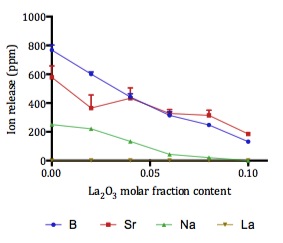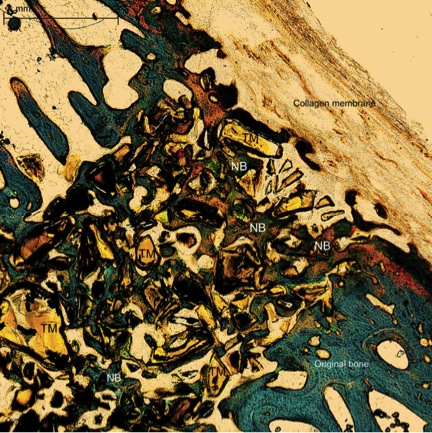Introduction: Borate (B) glasses exhibit excellent potential as bioactive materials, particularly for hard tissue augmentation [1],[2]. Historically, the low chemical durability of vitreous B was considered a negative attribute. However, it can be ascertained from the literature that compositional modifications may modulate material properties via structural alterations within the glass network. Accordingly, emphasis has been placed on achieving materials that (i) provide for indication specific material characteristics (i.e. appropriate durability) and, (ii) allow the release of biologically active therapeutic inorganic ions to modulate host responses. This study illustrates that substituting La2O3 or Ga2O3 into high B glasses provides significant modulation of composition-structure-property relationships and provides an interesting materials platform for applications in bone tissue engineering.
Materials and Methods: 11 glass compositions, across two series, (70B-20Sr-10-x(La/Ga)Na (x = 0, 2, 4, 6, 8, 10, mol%) were melted and processed to a particle size distribution of 45-150µm. Materials were subjected to structural analysis via magic angle spinning nuclear magnetic resonance spectroscopy. Glass transition temperatures (Tg) were determined by differential scanning calorimetry, while density measurements were obtained using helium pycnometery. Ion release kinetics for each element in each composition was determined by ICP-OES (up to 30-days). One glass, which provided linear strontium release (LB102, from the La glass series) was implanted in a femur healing defect model in New Zealand White Rabbits to evaluate its influence on bone repair. Histopathology was conducted after a 6-week implantation period using Goldner’s trichrome staining.
Results and Discussion: Ga2O3 appeared to stabilize the glass systems to a lesser degree than La2O3. Increasing substitutions of La2O3 for Na2O enhanced the durability of the glasses as observed from the release of B, Sr and Na ions.

La provided significant control over the modulation of Sr release kinetics; an influence, which was not mirrored with the inclusion of Ga. Linear Sr release profiles were observed for one particular composition of glass (LB102). Upon implantation this glass provided both osteoconduction and osseointegration local to the implants, as characterized by moderate bone formation (green stained areas) and multifocal bone-biomaterial apposition at the implant sites.

Conclusion: La2O3 additions, up to 10mol%, provided the greatest stabilization with respect to durability in ion release when compared to Ga2O3. The compositional modification of the La series provided for a B glass particulate with appropriate biocompatibility and bioactivity, so as (i) not to induce an adverse host response, (ii) allow for osteoconduction and osseointegration, and (iii) enhance bone formation. With respect to these data, the authors believe that this study provides an initial platform for the utilisation of B glasses for hard tissue augmentation.
AccelLabs, Montreal, Canada; CIT RÍSAM PhD Scholarship Programme (RDRP); NSERC (Discovery Award Program); The Canadian Foundation for Innovation
References:
[1] Rahaman, M. N. et al. (2011) Acta Biomater. 7, 2355–2373.
[2] Gu, Y., Huang, W., Rahaman, M. N. & Day, D. E. (2013) Acta Biomater. 9, 9126–9136.